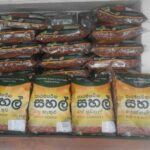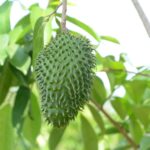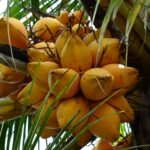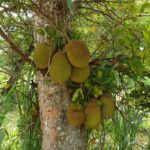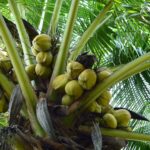OTHER CROPS AND PRODUCTS
In addition to TJC mango, the farm cultivates bananas, other fruit varieties and paddy.
There are also varieties of hard wood trees planted along the boundary and roadways of the farm. Two large earth ponds (wewas) collected rainwater and stores water for use in the dry season. The earth ponds also have fish which is used for consumption by the farm employees.
BANANA (KESEL)
Banana is the most abundantly available fruit in Sri Lanka. From the inception, we have been growing the Ambul variety of Banana on our farm.
Good post-harvest handling and natural ripening ensures that spoilage is limited and the flavour is retained.
WOOD APPLE (DIVUL)
Wood Apple – Limonia acidissima is a large tree growing to 9 metres (30 ft) tall, with rough, spiny bark. The leaves are pinnate, with 5-7 leaflets, each leaflet 25–35 mm long and 10–20 mm broad, with a citrus-scent when crushed. The fruit is a berry 5–9 cm diameter, and may be sweet or sour. It has a very hard rind which can be difficult to crack open, and contains sticky brown pulp and small white seeds.
The rind of the fruit is so thick and hard it can be carved and used as a utensil such as a bowl or ashtray. The bark also produces an edible gum. The tree has hard wood which can be used for woodworking.
The scooped-out pulp from its fruits is eaten uncooked with or without sugar, or is combined with coconut milk and palm-sugar syrup and drunk as a beverage, or frozen as an ice cream. It is also used in chutneys and for making Fruit preserves, jelly and jam.
COCONUT (POL)
The farm has more than 1000 coconut and king coconut trees.
Found across much of the world’s tropic and subtropic area, the coconut is known for its great versatility as seen in the many domestic, commercial, and industrial uses of its different parts. Coconuts are part of the daily diet of many people. Its endosperm is initially in its nuclear phase suspended within the coconut water. As development continues, cellular layers of endosperm deposit along the walls of the coconut, becoming the edible coconut “flesh”.[4] When dried, the coconut flesh is called copra. The oil and milk derived from it are commonly used in cooking and frying; coconut oil is also widely used in soaps and cosmetics. The clear liquid coconut water within is a refreshing drink and can be processed to create alcohol.
The husks and leaves can be used as material to make a variety of products for furnishing and decorating. It also has cultural and religious significance in many societies that use it.
KING COCONUT (THAMBILI)
King coconut is a type of a coconut fruit cultivated in Sri Lanka known as “Thambili”. Sweetness of the fruit is more than the regular coconut fruit. There are several varieties of “Thambili” as “Tambili”, “Ran Thambili”, “Gon Thambili” etc.
The nuts are regarded as a “living pharmacy” and is the most versatile and medically practical form of the coconut plant available. Sri Lankans sell and consume thousands of them on a daily basis.
In almost every Sri Lankan home irrespective of class, a king coconut palm swaying soothingly in the breeze is a common sight. Another familiar sight are the bunches of king coconuts displayed for sale in many wayside kiosk throughout the country.
JAMAICA PLUM (AMBERELLA)
Spondias dulcis, ambarella, (and its alternative binomial, Spondias cytherea, Malay apple), or golden apple, is an equatorial or tropical tree, with edible fruit containing a fibrous pit. It is known by many names in various regions, including pomme cythere in Trinidad and Tobago,[1] June plum in Bermuda, juplon in Costa Rica, jobo indio in Venezuela, caja-manga in Brazil, and quả cóc in Vietnam.
This fast-growing tree can reach up to 60 ft (18 m) in its native homeland of Melanesia through Polynesia; however, it usually averages 30 to 40 ft (9–12 m) in other areas. Spondias dulcis has deciduous, pinnate leaves, 8 to 24 in (20-60 cm) in length, composed of 9 to 25 glossy, elliptic or obovate-oblong leaflets 2.5 to 4.0 in (6.25-10 cm) long, finely toothed toward the apex.[2] The tree produces small, inconspicuous white flowers in terminal panicles, assorted male, female. Its oval fruits, 2.5 to 3.5 in (6.25–9 cm) long, are long-stalked and are produced in bunches of 12 or more. Over several weeks, the fruit fall to the ground while still green and hard, turning golden-yellow as they ripen. According to Morton (1987), “some fruits in the South Sea Islands weigh over 1 lb (0.45 kg) each”.
STAR FRUIT (KAMARANKA)
Carambola, also known as starfruit, is the fruit of Averrhoa carambola, a species of tree native to the Philippines, Indonesia, Malaysia, India, Bangladesh, and Sri Lanka. The fruit is a popular food throughout Southeast Asia, the South Pacific and parts of East Asia.
The fruit has ridges running down its sides (usually five); in cross-section, it resembles a star, hence its name. The number of ridges can vary.[2]
The carambola has been cultivated in parts of Asia for hundreds of years. Scientists believe that it may have originated in Sri Lanka or Moluccas, Indonesia.
The entire fruit is edible, including the slightly waxy skin, unlike other tropical fruits. The flesh is crunchy, firm, and extremely juicy, having a texture similar in consistency to that of grapes.
Star Fruits are best consumed when ripe, when they are yellow with a light shade of green. They will also have brown ridges at the five edges and feel firm. Overripe starfruit will be yellow with brown spots and can become soggier in consistency.
Ripe carambolas are sweet without being overwhelming, and have a tart, sour undertone. The taste is difficult to compare, but it has been likened to a mix of apple, pear, and citrus family
RICE
The farm has a 15 acre plot for paddy cultivation. Part of the farm’s rice is grown under ecological conditions. A limited quantity organic traditional and heirloom rice varieties are produced each season.

